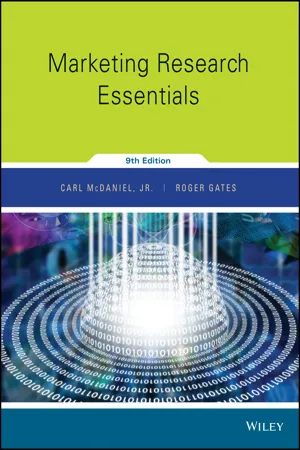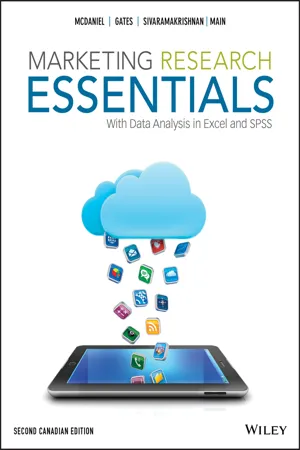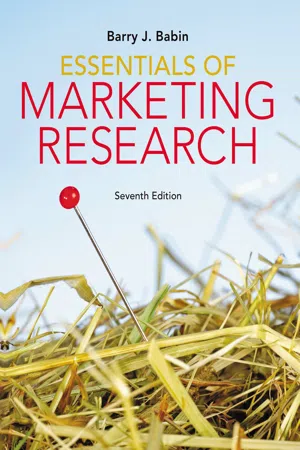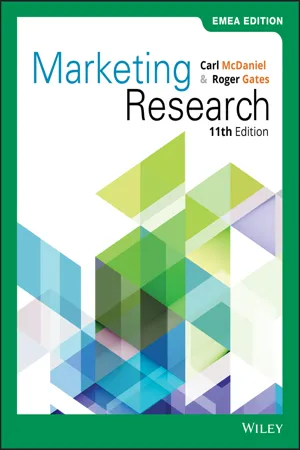Marketing
Experimental Research
Experimental research in marketing involves conducting controlled experiments to test the impact of specific marketing strategies or interventions. It typically involves manipulating variables and measuring their effects on consumer behavior or market outcomes. By using experimental designs, marketers can gain insights into causality and make more informed decisions about their marketing efforts.
Written by Perlego with AI-assistance
Related key terms
1 of 5
8 Key excerpts on "Experimental Research"
- eBook - PDF
- Carl McDaniel, Jr., Roger Gates(Authors)
- 2020(Publication Date)
- Wiley(Publisher)
Yet the amount of actual experimentation done in market- ing research is limited because of the high cost of experiments, security issues, and implementation problems. There is evidence to suggest that the use of experiments in marketing research is growing. Preexperimental designs offer little or no control over the influence of extraneous factors and are thus generally difficult to interpret. Examples include the one-shot case study design and the one-group pretest–posttest design. In a true experimental design, the researcher is able to eliminate all extraneous vari- ables as competitive hypotheses to the treatment. Examples of true experimental designs are the before and after with control group design and the after-only with control group design. In quasi-experiments, the researcher has control over data- collection procedures but lacks complete control over the sched- uling of treatments. The treatment groups in a quasi-experiment normally are formed by assigning respondents to treatments in a nonrandom fashion. Examples of quasi-experimental designs are the interrupted time-series design and the multiple time-series design. Test marketing involves testing a new product or some element of the marketing mix by using experimental or quasi- experimental designs. Test markets are field experiments and they are extremely expensive to conduct. The steps in conducting a test market study include defining the objectives for the study, selecting the basic approach to be used, developing detailed pro- cedures for the test, selecting markets for the test, executing the plan, and analyzing the test results. - eBook - PDF
- Carl McDaniel, Jr., Roger Gates(Authors)
- 2016(Publication Date)
- Wiley(Publisher)
For example, if an advertiser were testing a new advertising campaign in a test city, that city would constitute the experi- mental group and another city that was not exposed to the new campaign would be chosen as the control group. It is important that the test and control cities be roughly equivalent in regard to characteristics related to the sale of the product (e.g., competitive brands available). Test Markets The development of products and services goes through a sequence of steps, beginning with idea generation, screening of ideas, concept testing, business analysis, prototype development, test marketing, and commercialization. Marketers may or may not test market a product or service depending on its expected rate of diffusion, the degree to which it is different from existing com- petitive offerings, and a host of other factors. Test marketing is a common form of experimentation used by marketing researchers. The term test market is used rather loosely to refer to any research that involves testing a new product or change in an existing marketing strategy (e.g., product, price, place promotion) in a single market, group of markets, or region of the country through the use of experimental or quasi‐experimental designs. 11 interrupted time‐series design Research in which repeated measurement of an effect “interrupts” previous data patterns. multiple time‐series design Interrupted time-series design with a control group. test market Real-world testing of a new product or some element of the marketing mix using an experimental or quasi-experimental design. 164 CHAPTER 8 Primary Data Collection: Experimentation and Test Markets New product introductions play a key role in a firm’s financial success or failure. The conven- tional wisdom in the corporate world is that new products will have to be more profitable in the future than they were in the past because of higher levels of competition and a faster pace of change. - eBook - PDF
- Carl McDaniel, Jr., Roger Gates, Subramanian Sivaramakrishnan, Kelley Main(Authors)
- 2013(Publication Date)
- Wiley(Publisher)
Unilever has intro- duced Pureit to Latin America and sub-Saharan Africa, as well as other parts of Southeast Asia. Some marketers think that classic test marketing will make a comeback. For totally new products, more thorough testing may be necessary, while for other types of product introductions, such as line extensions, an alternative approach may be more appropriate. 315 Test Marketing LIMITATIONS OF Experimental Research As the preceding discussion shows, experiments are an extremely powerful form of research—the only type of research that can truly explore the existence and nature of causal relationships between variables of interest. Given these obvious advantages over other research designs for primary data collection, you might ask why experi- mental research is not used more often. There are many reasons, including the cost of experiments, the issue of security, and problems associated with implementing experiments. HIGH COST OF EXPERIMENTS To some degree, when making comparisons of the costs of experiments with the costs of surveys or observation-based research, we are comparing apples to oranges. Experiments can be very costly in both money and time. In many cases, managers may anticipate that the costs of doing an experiment would exceed the value of the infor- mation gained. Consider, for example, the costs of testing three alternative advertising campaigns in three different geographic areas. Three different campaigns must be pro- duced; airtime must be purchased in all three markets; the timing in all three markets must be carefully coordinated; some system must be put into place to measure sales before, during, and after the test campaigns have run; measurements of other extrane- ous variables must be made; extensive analysis of the results must be performed; and a variety of other tasks must be completed in order to execute the experiment. - eBook - PDF
- Barry Babin(Author)
- 2018(Publication Date)
- Cengage Learning EMEA(Publisher)
In social sciences, the actual laboratory may be a behavioral lab, which is somewhat like a focus group facility. However, the experimental procedures may turn a classroom or an area in a shopping center into an experimental lab. In a laboratory experiment the researcher maximizes control over the research setting and extraneous variables. For example, some advertising researchers recruit subjects and bring them to the agency’s office or perhaps a mobile unit designed for research purposes. Researchers then expose subjects to a television commercial within the context of a program that includes com-petitors’ ads among the commercials shown. While viewing the ads, a lie detector type device measures the subjects’ physiological arousal. The researcher measures trial purchase intentions for the focal product as well. In a short time span, the marketer is able to collect information on emotional responses and consumer decision making. Our retail atmospheric experiment also illustrates a laboratory experiment. Other laboratory experiments may be more controlled or artificial. For example, a tachistoscope allows a researcher to experiment with the visual impact of advertising, packaging, and so on by controlling the amount of time a subject sees a visual image. Each stimulus (for example, package design) is projected from a slide to the tachistoscope at varying exposure lengths (1/10 of a second, 2/10, 3/10, etc.).The tachistoscope simulates the split-second duration of a customer’s attention to a package in a mass display. Field Experiments Field experiments are research projects involving experimental manipulations implemented in a natural environment. They can be useful in fine-tuning marketing strategies and determining sales forecasts for different marketing mix designs. Facebook routinely implements field experiments by subjecting subscribers to various manipu-lations. - eBook - PDF
- Carl McDaniel, Jr., Roger Gates(Authors)
- 2020(Publication Date)
- Wiley(Publisher)
Security Issues Conducting a field experiment in a test market involves exposing a marketing plan or some key element of a marketing plan in the actual marketplace. Undoubtedly, competitors will find out what is being considered well in advance of full-scale market introduction. This advance notice gives competitors an opportunity to decide whether and how to respond. In any case, the element of surprise is lost. In some instances, competitors have actually “stolen” concepts that were being tested in the marketplace and gone into national dis- tribution before the company testing the product or strategy element completed the test marketing. experimental effect Effect of the treatment variable on the dependent variable. 190 CHAPTER 9 Primary Data Collection: Experimentation and Test Markets Implementation Problems Problems that may hamper the implementation of an experiment include difficulty gain- ing cooperation within the organization, contamination problems, differences between test markets and the total population, and the lack of an appropriate group of people or geo- graphic area for a control group. It can be extremely difficult to obtain cooperation within the organization to execute certain types of experiments. For example, a regional marketing manager might be very reluctant to permit her market area to be used as a test market for a reduced level of adver- tising or a higher price. Quite naturally, her concern would be that the experiment might lower sales for the area. Contamination occurs when buyers from outside the test area come into the area to purchase the product being tested, thereby distorting the results of the experiment. Outside buyers might live on the fringes of the test market area and receive TV advertisements— intended only for those in the test area—that offer a lower price, a special rebate, or some other incentive to buy a product. - eBook - PDF
- Roger Wimmer, Joseph Dominick(Authors)
- 2013(Publication Date)
- Cengage Learning EMEA(Publisher)
To counteract this problem, researchers can use the double-blind technique , in which nei-ther subjects nor researchers know whether a given subject belongs to the control group or to the experimental group. 3 . Limited scope. Finally, some research questions simply do not lend themselves to the experimental approach. Many of the more interesting research topics in mass media are concerned with the collective behavior of perhaps millions of people. Experiments on this scale are much too mas-sive to conduct. Consider, for example, the cultivation effect (discussed in more detail on this book ’ s website), which involves the long-term impact of television on society. Any experimental design that would “ test ” the cultivation effect would be too time-consuming, expensive, and ethically ques-tionable to take place. Although it is possible to conduct some smaller-scale experiments on this topic with small groups of subjects, it is unclear how these experiments relate to the larger-scale phenomenon. Chapter 9 Experimental Research 247 Copyright 2012 Cengage Learning. All Rights Reserved. May not be copied, scanned, or duplicated, in whole or in part. Due to electronic rights, some third party content may be suppressed from the eBook and/or eChapter(s). Editorial review has deemed that any suppressed content does not materially affect the overall learning experience. Cengage Learning reserves the right to remove additional content at any time if subsequent rights restrictions require it. CONDUCTING Experimental Research The experimental method involves both manipulation and observation. In the sim-plest form of an experiment, researchers manipulate the independent variable and then observe the responses of subjects on the dependent variable. Although every experi-ment is different, most researchers agree that the following eight steps should be followed when conducting an experiment: 1 . - eBook - PDF
Research Methods For Business
A Skill Building Approach
- Roger Bougie, Uma Sekaran(Authors)
- 2021(Publication Date)
- Wiley(Publisher)
CHAPTER 11 164 Experimental Designs In Chapter 7, we examined basic research strategies. We distinguished experimental from non- experimental approaches and explained that experimental designs are typically used in deductive research where the researcher is interested in establishing cause-and-effect relationships. In the last three chapters, we discussed non-experimental approaches to primary data collection. In this chapter, we look at experimental designs. Consider the following three scenarios. INTRODUCTION Example Cause-and- effect rela- tionship after randomization Scenario A A manufacturer of luxury cars has decided to launch a global brand commu- nications campaign to reinforce the image of its cars. An 18-month campaign is scheduled that will be rolled out worldwide, with advertising in television, print and electronic media. Under the title ‘Bravura’, a renowned advertising agency developed three different campaign concepts. To determine which of these concepts is most effective, the car manufacturer wants to test their effects on the brand’s image. But how can the car manufacturer test the effectiveness of these concepts? Scenario B A study of absenteeism and the steps taken to curb it indicates that com- panies use the following incentives to reduce it: 14% give bonus days; 39% offer cash; 39% present recognition awards; 4% award prizes; 4% pursue other strategies. LEARNING OBJECTIVES After completing Chapter 11, you should be able to: 1. Describe lab experiments and dis- cuss the internal and external validity of this type of experiment. 2. Describe field experiments and dis- cuss the internal and external validity of this type of experiment. 3. Describe, discuss and identify threats to internal and external validity and make a trade-off between internal and external validity. 4. Describe the different types of experi- mental designs. 5. Discuss when and why simulation might be a good alternative to lab and field experiments. - Ronald C. Martella, J. Ron Nelson, Robert L. Morgan, Nancy E. Marchand-Martella(Authors)
- 2013(Publication Date)
- The Guilford Press(Publisher)
The goal of many Experimental Researchers is to find general laws that hold true for large numbers of people. Thus, the attempt is to gather a sample of partici- pants for an investigation that is representative of the entire population or some target popula- tion. (Note. Sampling methods are discussed in Chapter 4.) Experimental Methods A major feature of much experimental or group research is the attempt to find cause-and-effect Causal– Comparative Naturalistic/ Descriptive Case Study Correlational Experimental Experimental/ Group Single Case Quantitative Qualitative Quantitative– Qualitative Mix Chapter 6 Chapter 7 Chapters 9 and 10 Chapters 4 and 5 (group) and 11–13 (single case) High Constraint Low Constraint FIGURE 1.6. Continuum of constraint levels for different research methods. Note. The categories of quanti‑ tative and qualitative methods are for general guidance only, since case study and naturalistic and descrip‑ tive research methods can also fall under the category of quantitative research, depending on how the data are collected and analyzed. Survey research (Chapter 8), program evaluations (Chapter 14), and action research (Chapter 16) can also have aspects of both quantitative and qualitative research methods. 1. Thinking Critically about Research 23 relationships. In order to do this, researchers manipulate the independent variable. Recall that an independent variable may have an effect on the dependent variable. For example, a computer tutorial used in your class can be considered an independent variable, and the knowledge the students gain is the dependent variable. An Experimental Researcher may provide the com- puter tutorial to your class and not to another, and make comparisons on a test at the end of some specified period of time. Thus, the assump- tion is that the researcher can determine whether the independent variable (i.e., computer tutorial) caused changes in the dependent variable (i.e., knowledge gained).
Index pages curate the most relevant extracts from our library of academic textbooks. They’ve been created using an in-house natural language model (NLM), each adding context and meaning to key research topics.







